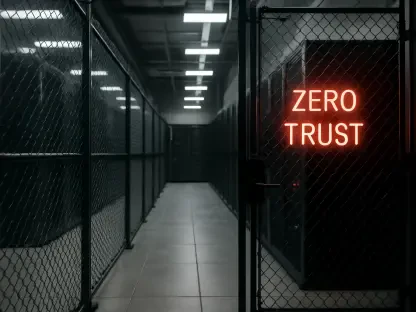In a world increasingly reliant on digital infrastructure, a staggering statistic emerges from the heart of North America’s data center industry: colocation capacity has dwindled to a mere 2.3% vacancy rate, signaling an unprecedented crisis that challenges businesses, governments, and tech providers. This near-zero availability, a historic low, underscores a pressing issue as demand for cloud services, AI applications, and data storage skyrockets, threatening to stall technological progress and economic expansion. This analysis delves into the depth of this capacity crunch, exploring its causes, regional disparities, financial hurdles, and potential pathways forward in an era where digital connectivity is non-negotiable.
The Depth of the Capacity Shortage
Alarming Trends and Statistics
The current state of data center colocation capacity in North America paints a grim picture for industries dependent on digital infrastructure. With vacancy rates plummeting to 2.3% in the latest reports, a sharp decline from higher levels just a few years ago, the market has never been tighter. Projections indicate that this scarcity will persist, with vacancy rates expected to remain below 5% through 2027, leaving little room for new entrants or expansions.
Compounding the issue, a significant portion of new capacity is already spoken for before it even comes online. Approximately 73% of the 8 GW construction pipeline is pre-leased, meaning that even forthcoming projects offer no immediate relief to companies desperate for space. This trend forces businesses to endure lengthy delays, often waiting a year or more to secure a spot in future developments.
The ramifications of these tight market conditions are far-reaching. Enterprises looking to scale their operations face not only logistical challenges but also increased costs as competition for limited space intensifies. This bottleneck stifles innovation and hampers the ability to meet growing consumer demand for digital services.
Regional Growth and Disparities
Despite the overarching shortage, certain regions in North America have seen remarkable growth in data center capacity over recent years. Columbus, Ohio, stands out with an extraordinary 1800% increase, while Austin and San Antonio have collectively expanded by 500%, though these figures stem from smaller initial bases. Meanwhile, in absolute terms, hubs like Northern Virginia have added a massive 3,975 MW, alongside significant gains in Dallas and Atlanta.
Looking at development pipelines, key markets are poised to address some of the demand, though disparities remain evident. Northern Virginia leads with a 7 GW pipeline, followed by Phoenix and Dallas at 5 GW each, Chicago at 4 GW, and emerging areas like Las Vegas and Reno also showing promise. These figures highlight a concentrated effort to build in established and upcoming hubs, reflecting strategic responses to regional needs.
However, this uneven distribution underscores a critical challenge: while certain areas surge ahead, others lag, creating a patchwork of availability. Businesses outside major hubs may struggle even more to access necessary infrastructure, exacerbating regional economic inequalities and potentially redirecting investment toward already saturated markets.
Financial and Operational Barriers
The Cost of Closing the Gap
Addressing the capacity crisis comes with a staggering price tag that could reshape the industry landscape. Estimates suggest that up to $1 trillion in investment is required for new data center construction to meet current and projected demand. This monumental financial challenge places immense pressure on providers to secure funding while navigating rising costs of land, materials, and labor.
For customers, the ripple effects are equally significant. As providers grapple with these investment needs, the cost of colocation services is likely to rise, potentially pricing out smaller businesses or startups. This dynamic risks creating a divide where only large corporations can afford the necessary digital infrastructure, limiting market diversity.
Moreover, the sheer scale of required capital raises questions about accessibility and sustainability. Governments and private sectors must collaborate to find innovative funding models, lest the gap between supply and demand widens further, impacting the affordability of critical services across industries.
Power Supply Bottlenecks
Beyond financial constraints, a less visible but equally crippling barrier looms over data center expansion: power supply delays. In North America, the average wait time for grid connections stretches to four years, a timeline that severely hampers the ability to bring new facilities online. This bottleneck is a fundamental obstacle, as power is the lifeblood of data center operations.
Such delays not only slow down construction but also deter investment in regions where energy infrastructure lags. Businesses reliant on rapid deployment of digital solutions find themselves stuck, unable to scale operations in line with market demands. The energy crunch thus amplifies the capacity crisis, creating a vicious cycle of unmet needs.
Solving this issue requires more than just building new facilities; it demands a reevaluation of energy policies and infrastructure planning. Without expedited grid connections or alternative power solutions, the industry risks prolonged stagnation, leaving critical digital advancements on hold.
Industry Perspectives on the Crisis
Insights from industry analyses reveal a market under sustained pressure with no quick fixes in sight. Experts note that pre-leasing trends and extended construction timelines ensure the capacity crunch will linger for years. This persistent constraint shapes a landscape where supply struggles to keep pace with relentless demand driven by digital transformation.
A broader consensus within the sector highlights a dual reality: while high demand benefits data center providers through guaranteed revenue, it poses significant challenges for customers facing limited options and long wait times. This imbalance creates a competitive environment where strategic planning becomes essential for businesses seeking to secure space.
Additionally, uncertainty surrounds the role of AI-specific facilities in this crisis. While AI-driven demand contributes to the shortage, distinctions between specialized AI setups and general colocation spaces complicate projections. This complexity suggests that solutions must address a spectrum of needs rather than focusing on a single driver of growth.
Looking Ahead: Implications and Solutions
As the data center capacity shortage persists, low vacancy rates and ongoing power supply challenges remain formidable hurdles. The trajectory suggests that without significant intervention, businesses across sectors will continue to face barriers to digital expansion. This scenario could slow technological innovation, impacting everything from cloud computing to AI development.
Potential solutions lie in multiple avenues, including accelerated investment to fund new projects at scale. Innovative construction approaches, such as modular designs, could speed up deployment, while policy reforms to streamline grid connections might alleviate power bottlenecks. Collaboration between public and private entities will be crucial to implement these strategies effectively.
The broader implications extend across industries reliant on robust digital infrastructure. For providers, the crisis presents economic opportunities through heightened demand, but for users, it poses operational risks, potentially delaying critical advancements. Balancing these dynamics will shape how technology evolves in the coming years, determining whether the digital economy can sustain its rapid growth.
Navigating the Capacity Crunch
Reflecting on the critical findings, the data center capacity crisis in North America reveals a dire 2.3% vacancy rate that underscores a historic shortage. A substantial 73% of the 8 GW construction pipeline has already been pre-leased, limiting immediate relief, while an estimated $1 trillion investment need looms large over the industry. Power delays, averaging four years, have further complicated efforts to expand infrastructure, intensifying the strain on digital growth.
Moving forward, stakeholders need to prioritize strategic investments to bridge this gap, focusing on innovative funding and construction methods to expedite capacity increases. Collaborative efforts to address power supply issues through policy advocacy and alternative energy solutions emerge as vital steps. By building a resilient digital framework, the industry can support sustained economic progress and technological innovation, ensuring that the backbone of the digital age does not falter under pressure.









